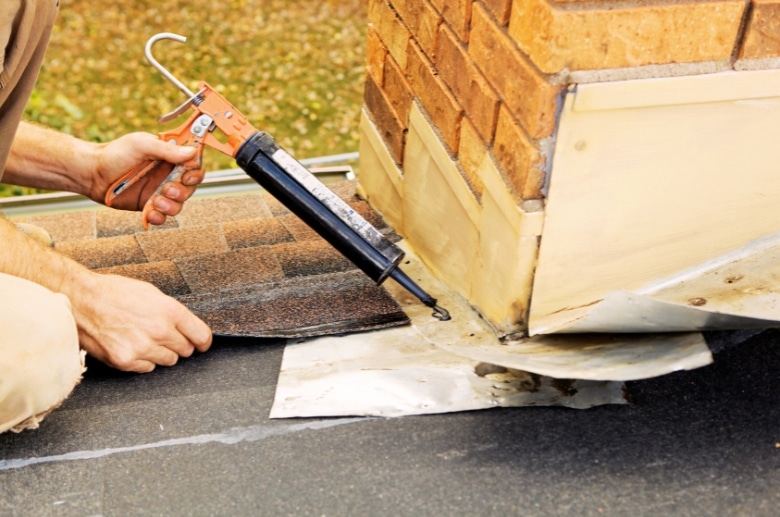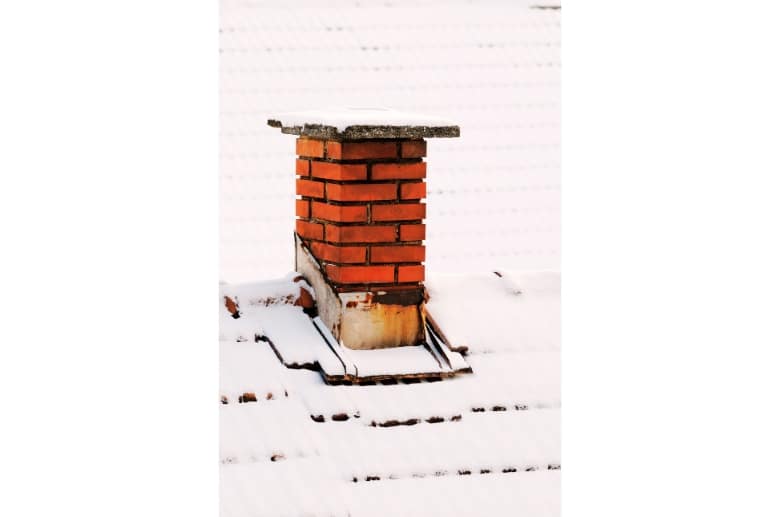When Should Chimney Flashing be Replaced? (Expert Tips)
Chimney flashing, whether in your home or rental property, is vital in safeguarding your structure from water damage and structural problems. It acts as a protective barrier, keeping rain, snow, and debris out of the vulnerable area where your roof meets the chimney. Without proper chimney flashing, your chimney and residence become susceptible to leaks, mold, rot, and fire hazards.
Given the serious risks associated with damaged flashing around chimneys and roofs, homeowners must remain vigilant and promptly contact professional services upon spotting warning signs. However, it’s crucial to address the fundamental question: when should chimney flashing be replaced?
When Should Chimney Flashing be Replaced?

Let’s get straight to the point: chimney flashing should be replaced when it’s damaged beyond repair or has reached the end of its lifespan. A chimney flashing’s lifespan is up to 25 to 30 years.
In this context, it’s important to also consider the condition of the chimney saddle, a crucial component that helps divert water away from the chimney.
However, it should be replaced immediately if worn out, deteriorated, or rusted. It’s not something to gamble with because improper flashing or a faulty chimney saddle can lead to water leaks, costly repairs, and even structural damage.
Always hire a professional chimney service for inspection and replacement to ensure it’s done right. Incorrectly installed chimney flashing can do more harm than good.
Signs that Flashing Needs to Be Replaced
How do you know when it’s time for a chimney flashing replacement? Look for these red flags:

- Rust and Corrosion: This is especially relevant for stainless steel flashing. When rust starts eating away at your flashing, it becomes less effective at sealing your chimney. This can affect your chimney cap and lead to water damage, moisture, and mold.
- Cracks and Gaps: These can develop due to harsh weather, allowing water to seep through holes in your stone or brick masonry and cause chimney leaks.
- Wear and Tear: Chimney flashing, like anything, naturally breaks down over time as the seasons change. Signs of wear, like cracks, can signal that it’s time for a replacement.
- Water Stains: If you notice water stains on your wall, ceiling, or around your fireplace or if you hear dripping sounds, it’s a clear indication that your flashing might be failing and need immediate replacement.
- Missing Pieces: Flashing should be intact. Missing pieces of flashing can leave your chimney vulnerable to water damage.
- Wood Rot: Inspect your attic and nearby wooden structures for any signs of rot, as this can indicate prolonged moisture exposure from faulty flashing. When moisture is left unchecked, this can lead to the growth of mold spores.
- Mold Growth: As previously said, mold thrives in damp environments. If you spot mold growth around your chimney, addressing the issue promptly is essential, as it can greatly affect your health when inhaled.
——
Do You Need to Hire Chimney & Fireplace Expert?
Get free quotes from qualified experts near you. No commitment required!
——
Factors that Affect Flashing Lifespan
Several factors impact how long your chimney flashing will last. Let’s look at the most important ones that will help your decision-making.
Quality of Materials
Investing in high-quality materials can extend your flashing’s lifespan. Let’s compare the three most common chimney flashing materials.

- Aluminum flashing is the most cost-effective and malleable. As a bonus, paint adheres well. However, it can pit and oxidize in salty or polluted environments and corrode when in contact with certain materials like pressure-treated wood or concrete. Aluminum also can’t be soldered, limiting its use to simpler profiles.
- Stainless steel is stronger than copper but susceptible to rust. As a type of metal flashing, this is the most preferred choice. If you choose galvanized steel, it has a zinc coating for rust prevention but may also wear over time.
- Copper flashings are durable and resist corrosion, developing an attractive patina. Soft copper is ideal for intricate details, while cold-rolled copper offers more strength. Copper lasts longer than aluminum and stainless steel, but it is the most costly of the three.
Weather and Climate

Harsh weather conditions, especially those with frequent freeze-thaw cycles, can accelerate wear and tear on your flashing. Freeze-thaw damage results from excessive water within or on the surface of building assemblies, leading to two types of harm:
surface spalling and internal cracking.
According to a study by the National Institutes of Health, flashing damage is 54% more likely in areas with frequent freeze-thaw cycles.
Installation Expertise
Properly installed flashing is more likely to stand the test of time. Skilled professionals like roofers can make a significant difference rather than doing it yourself. If the flashing wasn’t correctly installed in the first place, it’s more likely to become loose and let water seep in behind it
With correct installation and regular inspections done by a roofing contractor, chimney flashing can endure for 30 years or more. Proper installation is essential to secure and waterproof the flashing.
Chimney Complexity
A chimney’s complexity can impact flashing longevity. Complex chimneys are harder to flash correctly, increasing the risk of leaks and problems. While well-constructed chimneys and flashing can last years, complexity can influence the lifespan.
If your chimney has a complex structure with more potential wear points, it might require more frequent maintenance.
Maintenance Frequency
Regular inspections and timely repairs can significantly extend the lifespan of your chimney flashing. Delaying flashing repairs can lead to severe structural damage.
Furthermore, moisture infiltration through the roofing material into the attic can harm various components, including drywall and wood, and may result in costly repairs if neglected. Therefore, it’s best to get regular maintenance to avoid more repair costs.
——
Do You Need to Hire Chimney & Fireplace Expert?
Get free quotes from qualified experts near you. No commitment required!
——
Chimney Flashing Replacement Cost
Now, let’s see the average chimney flashing repair cost. To provide you with accurate figures, we’ve gathered information from various reputable sources.
Material Costs
- Copper Flashing: Copper is a premium material known for its durability. It offers excellent protection against corrosion and can last for decades. The cost of copper flashing can range from $15 to $30 per linear foot, with an average of $600, depending on factors like thickness and quality.
- Aluminum Flashing: While budget-friendly and malleable, aluminum flashing is susceptible to pitting and oxidation when unprotected. Therefore, it is advisable to paint aluminum flashing to preserve its integrity, and this can last for 10 to 15 years. The cost of aluminum flashing typically falls between $4 to $9 per linear foot for a total of about $200.
- Steel Flashing: Steel flashing is a more affordable alternative to copper. Steel flashing costs approximately $7 to $15 per linear foot, averaging $475. However, it is susceptible to rust and may have a shorter lifespan, lasting only 25 years.
Labor Costs
The labor cost for chimney flashing replacement depends on factors like damage extent, chimney size, and roof complexity. Usually, homeowners can anticipate labor costs ranging from $30 to $180 per hour.
For projects spanning four hours, total labor charges may fall within the $150 to $750 range. You can expect to pay between $600 and $1,500 for labor, on average.
Overall Cost
Both material and labor costs determine the overall cost of chimney flashing replacement. For a typical project, which includes mid-range materials and professional installation, you can expect to spend anywhere from $1,000 to $3,000.
Cost-saving Tips
Consider the following tips to help you manage the cost of chimney flashing replacement.
Regular Maintenance
Keep up with regular inspections and maintenance to extend the lifespan of your flashing. Instead of waiting for damage before repairing your chimney flashing, consistently checking its parts and condition will help prevent costly repairs and deterioration.
——
Do You Need to Hire Chimney & Fireplace Expert?
Get free quotes from qualified experts near you. No commitment required!
——
Partial Repairs
In some cases, it’s possible to repair damaged sections of flashing rather than replace the entire system, which can save you money.
For instance, if you only need a section to be repaired, you can buy only a foot of copper flashing material which will cost about $20, instead of buying materials for the whole chimney, which will cost around $500.
Compare Quotes
Before selecting a contractor, conduct thorough research. Request to view their portfolio to gauge their qualifications and work experience.
Ask for before-and-after photos of nearby projects to assess their craft and process. Also, obtain at least three quotes for comparison and look into their service reviews.
While one of these quotes will typically be the most affordable, it’s important to remember that the lowest quote doesn’t always equate to the best value.
Financing Options
Some contractors offer financing options to help spread the replacement cost over time.
Moreover, you may consider a HUD-insured Title I Property Improvement loan to assist in covering the expenses associated with chimney flashing and roof replacement. Loans below $7,500 do not necessitate home collateral; a signature alone is sufficient.
To make it easier, here’s a table summarizing all those costs, such as products and requirements regarding chimney flashing replacement.
| Material Costs | Cost Range per Linear Foot |
| Copper Flashing | $15 – $30 |
| Aluminum Flashing | $4 – $9 |
| Stainless Steel Flashing | $7 – $15 |
| Labor Costs | Cost Range |
| Labor (Per Hour) | $30 – $180 |
| Labor (4-Hour Project) | $150 – $750 |
| Overall Cost | Cost Range |
| Materials + Labor | $1,000 – $3,000 |
Conclusion
Chimney flashing might not be the most glamorous part of your house. Still, it plays a critical role in protecting your home from water damage and structural issues. Timely replacement is key to ensuring your home’s safety and longevity.
Don’t leave it to chance – schedule a professional chimney inspection with a chimney company and rest easy knowing your chimney is in good hands. Your home deserves it, and so do you.






